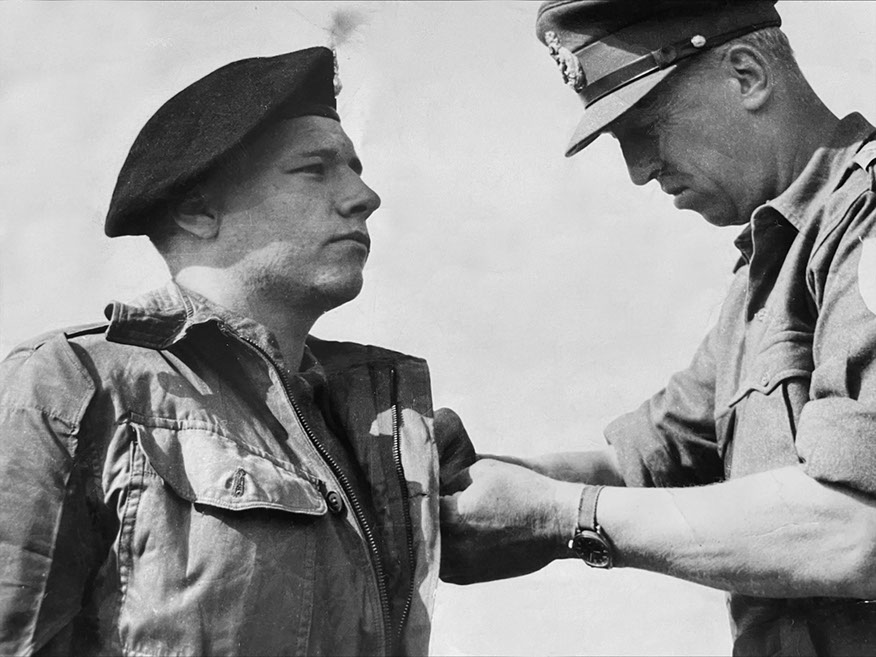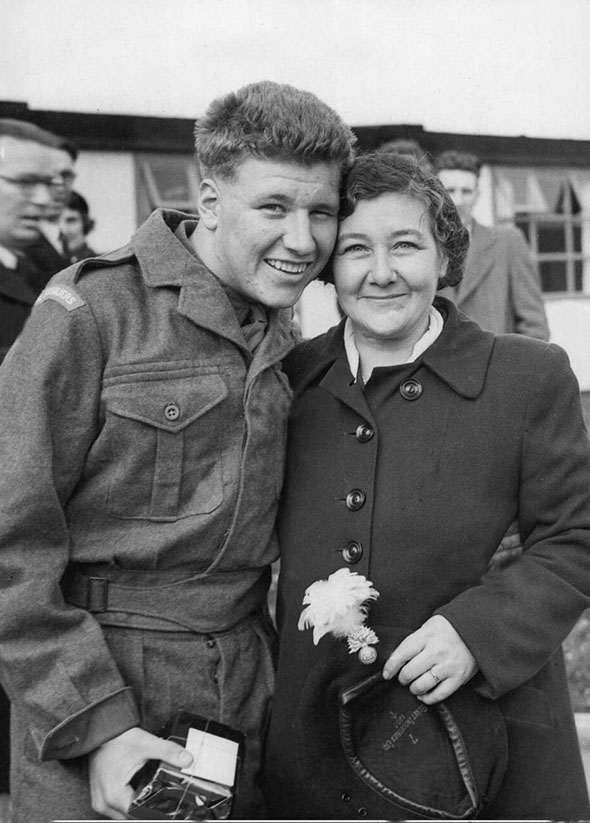
1st Bn Royal Fusiliers and Royal Regiment of Fusiliers (London) Branch of the Fusiliers Association

George Hodkinson DCM
He had probably never read the advice in Kipling’s poem The Young British Soldier, but in Korea in November 1952, 18-year-old George Hodkinson did what Kipling advised anyway: “If your officer’s dead and the sergeants look white, /Remember it’s ruin to run from a fight: /So take open order, lie down, and sit tight, /And wait for supports like a soldier.”
Except that supports never came; only the enemy, time and again, and at last in overwhelming numbers.
Fusilier (private) Hodkinson was a member of a 23-man raiding patrol from 1st Battalion, The Royal Fusiliers (City of London Regiment) — 1RF. After two and a half years of offensives and counter-offensives, yo-yoing the length of the Korean peninsula, North Korean and Chinese troops faced South Korean and UN troops (largely US and Commonwealth) in defensive positions the width of the peninsula astride the 38th parallel demarcating the two polities.
Operation Pimlico
The Commonwealth Division’s sector was centred on “the Hook”, a crescent-shaped ridge where the UN main line of resistance turned sharply southwest away from the natural line of the Sami-Chon valley, and which guarded the road to Seoul, the South Korean capital. Fighting had regressed to trench warfare, with patrolling, principally at night, to dominate no man’s land. There had been ferocious attacks by Chinese infantry in early November, all beaten back, and the front then seemed to go quiet. Having arrived in Korea in August, 1RF had taken over a stretch of the Hook defences in the aftermath of these attacks. They mounted a series of platoon-sized probes to gain “patrol ascendancy”, and then on the night of November 24-25 a raid on enemy lines in company strength — “Operation Pimlico”.
No 10 Platoon, D Company, was led by Second Lieutenant Christopher Hoare, just turned 21, an old boy of Stonyhurst who had joined straight from Sandhurst when the battalion sailed for Korea. Hodkinson was his radio operator. The platoon’s mission was to sweep the Kigong-Ni ridge, north of the Hook, and establish a firm base on the mound at the western end for No 12 Platoon to pass through and on to its objective. All patrols were under orders to take prisoners for interrogation if the opportunity arose.
Shortly after dark, 10 Platoon slipped through the gap in the mine belt in front of the battalion’s position. Not long afterwards, on hearing movement in a re-entrant to their left, Hoare ordered one section to cover him while he and the remainder of the platoon went to investigate. During this manoeuvre, his cover section shot and wounded a Chinese soldier, who ran off into scrub. Alerted to the likely presence of a Chinese patrol — later estimated to be a company some hundred-strong — Hoare and his party quickly rejoined the cover section and took up a temporary defensive position. He then shed his heavy equipment and flak jacket to search for the wounded man. Hoare managed to bring him in, but the man died almost immediately.
Half an hour later, at about 7.30pm, the patrol swept the Kigong-Ni ridge and occupied the mound. Almost at once they came under mortar fire, which continued at intervals till midnight.
In the early hours the Chinese attacked with sub-machineguns and grenades, but were beaten back. Hoare, though wounded, went after them, throwing a phosphorous grenade and calling on them to surrender.
The Chinese attacked again, repeatedly, to the disconcerting sound of bugles, and the Fusiliers’ casualties began to mount. At about 2.30am, Hoare was killed. In the hours before dawn that followed, all the platoon’s NCOs were killed or wounded. Hodkinson, the platoon commander’s radio operator and so deemed to be the senior, took command of the remnants, though himself wounded in the leg and face by shrapnel, while his radio had stopped two bullets. He refused to have his facial wounds dressed, saying that he couldn’t operate his radio with a field dressing on his face, and moved further into the open to get a better signal to call for artillery support. When the company commander proposed to counterattack, Hodkinson warned him: “Don’t come that way, sir. There are tons of Ch***ies between you and us.”
After another hour or so of intermittent Chinese attacks, the Fusiliers’ ammunition ran out. Hodkinson, who had coolly radioed situation reports throughout, received the order to abandon the position, with the remnants to make their way back as best they could. He replied, “We can’t carry our wounded so we can’t leave.” His last words on the radio were, “This is it. You can now consider our position overrun. This looks like the final wave, sir, they’re coming, they’re charging.” He was then knocked unconscious by a grenade blast.
Drummer Boy
George Arthur Hodkinson, known to army friends as “drummer boy”, with a nod perhaps to Kipling’s heroic but cheeky drummer boys in The Drums of Fore and Aft, was born in Bermondsey, southeast London, in 1934, to a railway labourer and his wife. He had six siblings, and they were evacuated to Devon when war broke out in 1939. After leaving school he became an apprentice boilermaker at Bow railway sidings.
A fit, solidly built 5ft 8in boxer, Hodkinson enlisted as soon as he was old enough, in 1951, and to the dismay of his father, but somewhat unwittingly into The East Surrey Regiment. He went with them to Libya, but the following year, volunteers were called for to join The Royal Fusiliers bound for Korea. He had never heard of Korea before the war began, but he had always wanted to be with “mates” in what was his local regiment, so he “rebadged”.
Some 50 per cent of 1RF were national servicemen, including the Kray brothers and Fusilier Maurice Micklewhite, aka Sir Michael Caine. The Krays were under military lock and key already, however, and most of the others were either reluctant soldiers or else, like Caine, had volunteered for active service to have their two-year period of conscription shortened to 18 months.
A genuine volunteer like Hodkinson would have been a godsend to his platoon commander, although many a reluctant conscript found an unexpected aptitude for soldiering and would afterwards prolong their service. Some, indeed, would find Korea an eye-opener. Caine related in his autobiography how he went to Korea with sympathetic feelings towards communism, having been raised in an impoverished family, but that the “human wave attacks” left him with the sense that the Chinese and North Korean governments had no care for their citizens. Caine would draw on this experience in the film A Hill in Korea, which tells the story of a group of British soldiers cut off by Chinese forces.
When Hodkinson came to after being blown unconscious, he was on a Chinese stretcher. He had all but lost his left eye, and shrapnel had lodged just above his right. The PoW camp, near the Yalu river, the border with China, was a march of some 300 miles, the first half on a stretcher, the second half, at his insistence, on foot. He was, by his own account, well treated in the camp, including by an eye surgeon “who spoke perfect English” and had trained at Moorfields hospital in London, not far from Hodkinson’s home. The surgeon could not save his eye, however. The food was predictably unvarying — “buckets of soup” — and he caught malaria, from which he suffered periodically all his life. The worst thing, at least in retrospect, was the hectoring “lectures” by the Chinese and North Korean political officers.
First newspaper reports of the action listed Hodkinson as “missing”, and it was some months before his family learnt that he was a PoW. He was released in April 1953 in what was known as the “little switch”, when wounded PoWs were exchanged, and then repatriated by “elderly Dakota” via Malta. On reaching England he learnt that he had been awarded the Distinguished Conduct Medal, second only to the Victoria Cross for courage, and in a league of its own for service above and beyond the expectation of rank. The recommendation for the award cited his “outstanding devotion to duty and leadership”, inspiring those around him and his “calm and determined radio transmissions”, which inspired those further back. Thirteen men had been killed, and only six had been able to get back to the battalion position, all of them wounded. It was, wrote his commanding officer simply, a “heroic stand”.
Hodkinson was medically discharged that year, but served as a reservist until 1957. In 1954 he married Margaret Barnes, a cashier with Barclays Bank in Pall Mall. They had met at a mutual friend’s party. Margaret died in 2020. Three of their four children survive him: Janet, an Ofsted inspector; Barbara, an events manager; and Michael, a deliveryman.
Hodkinson worked for his father-in-law as a builder for some years before going into the haulage business, and then towards the end of his working life was a clerk for the Mercers’ Company in London. He was an active member of the British Korean Veterans Association, with whom he travelled to America, Australia and South Korea. He never complained, regretted nothing, and remained the “cheeky Cockney” to the end.
George Hodkinson DCM, Royal Fusilier and Korean War veteran, was born on January 3, 1934. He died on January 11, 2024, aged 90
Please click on the link, if you wish to watch a really nice video clip which relates to 1RF’s time in Korea and includes George (and his Mum).

May 1, 1953. Fusilier G.S. Hodkinson, D.C.M. of Bermondsey, poses with his mum on the tarmac at Lyneham RAF Station, after a RAF plane had brought home 22 of the British prisoners of war released in Korea. Immediately after he had been freed it was announced that Fusilier Hodkinson had been awarded the D.C.M. for the part he played in the action during which he was capture.
1st Bn Royal Fusiliers and Royal Regiment of Fusiliers (London) Branch of the Fusiliers Association
Secretary
Ray O'Brien
5 Ashurst Drive, Worth, Crawley,
West Sussex RH10 7FS
Tel: 07988 833944
Email: rayobn1@gmail.com
President
Colonel M J Dudding OBE TD DL
Chairman
Lieutenant Colonel K W Kiddie
Treasurer
George Rose
36 Maryfield Close, Bexley,
Kent DA5 2HY
Tel: 01322 550285
The White Hackle editor
Rob Crowley
2 Keswick Road,
West Wickham, Kent BR4 9AT
Tel: 07702 008446